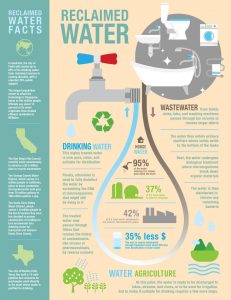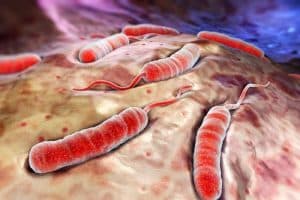 This week, May 3-9, is Drinking Water Week 2015, which is sponsored by the American Water Works Association (AWWA) and themed “What do you know about H2O?” Water is essential to life, and is the mainstay of civilization. People need water every single day not just for drinking, but also for industrial, agricultural, medical, and recreational needs. Reliable access to clean, safe water is critical to the health and success of society.
This week, May 3-9, is Drinking Water Week 2015, which is sponsored by the American Water Works Association (AWWA) and themed “What do you know about H2O?” Water is essential to life, and is the mainstay of civilization. People need water every single day not just for drinking, but also for industrial, agricultural, medical, and recreational needs. Reliable access to clean, safe water is critical to the health and success of society.

Drinking Water Week encourages the public to get to know their H2O and to understand how crucial water is to our daily lives. And while we have written about many water issues including sustainable development, water conservation, water reclamation, the criticality of water, where our water comes from, and the criticality of investing in our nation’s aging infrastructure, there is a constant: America has one of the safest drinking water supplies in the world, and in fact boasts 100 percent access to clean water and improved sanitation. So this week we’d like to take a step back in time and learn about the history of water distribution and sanitization.
HISTORY OF DISTRIBUTION
Mesopotamia — 3100 BC
Since the beginning of civilization, access to ample water has been paramount. Around 3100 BC, the first historically accepted civilization of people settled in Mesopotamia, the land made rich and fertile by the cyclical flooding of the Tigris and Euphrates Rivers. Ancient civilizations were always located near ample water supplies, and even ancient walking paths were routed past springs or streams. Ancients heavily prized any water supply that was clear, clean, and abundant, and the people would often dig wells to make collection easier as well as construct protective structures around these sources.
Persia — 700 BC
The first engineered distribution system came in the form of “qanats” in ancient Persia, now Armenia, around 700 BC. These qanats, which were open tunnels dug into hillsides, pushed groundwater from the hills to nearby cities or towns. The use of qanats became widespread and some still exist today. In fact, until 1933, the entire water supply of the Iranian capital city of Tehran was drawn from qanats.
Roman Empire — 312 BC

Next came the Roman aqueducts, which were constructed both above and below ground between 312 BC and 455 AD. These aqueducts used gravity flow to bring water from distant sources into the cities, and some of these impressive structures are still in existence today. The longest aqueduct was the Aqua Marcia, which brought water from a source 23 miles outside the city of Rome. The actual length of the aqueduct was 57 miles due to its meandering twists and turns along the countryside that were necessary to maintain the steady downhill flow of water. Constructed in 144 BC, the Aqua Marcia was mostly underground. Only the last seven miles of the aqueduct were above ground, ending at Rome’s distribution reservoirs, from which the water was transported to fountains and baths. Only very few wealthy individuals had water piped directly into their homes. Pipes were mostly made of hollowed out logs or drilled stone, but a few were made of clay and lead as well.
Incas — 1450

One of the most wondrous examples of early hydraulic engineering is the Incan “Stairway of Fountains,” built around 1450 at the city of Machu Picchu. The fountains supplied the entire city with fresh springwater from a pair of rain-fed springs atop the mountain. At the main spring, which was a full half mile away from the first of 16 fountains, Incan engineers designed and constructed a 48-foot long permeable wall that fed a stone-lined canal which also collected water from the second, smaller spring. The canal, which was roughly both five inches wide and deep, had an average grade of three percent and could carry up to 80 gallons per minute, which was twice as much water as the peak flow for the springs. In this way, Incan engineers even prevented overflow and loss. The water flowed to the fountains, which were linked by stone channels that formed a 180 foot long cascade of water, or “water stairs”, with a total vertical drop of 65 feet. All of the fountains, even the emperor’s, were publicly accessible save for the last one, which was located inside the Temple of the Condor. This amazing early engineering feat not only provided a safe, dependable public water supply, but also served to protect the hillside architecture from erosion.
Boston, MA — 1652

In 1652, Boston became home to the nation’s first waterworks, formed to provide water for fire-fighting and domestic usage. Fires were a common hazard in that time period of wood-framed homes and fireplaces, and a ready water supply was paramount. Bored-out logs were constructed from ten-inch thick hemlock or elm trees, cut into seven to nine foot lengths, and attached together with pitch or tar, or sometimes even iron hoops. In Boston, the line supplying the bustling community on the waterfront ran from Jamaica Pond to the Faneuil Hall area.
Wood proved problematic for several reasons: uneven ground caused the logs to sag and hold stagnated water, insects infested the pipes, the wood rotted, and the water often tasted woody. In addition, the increased pressure required to pump water into rapidly expanding cities began splitting the wooden pipes. Around this same time, iron became more readily available, and cities began using it in their distribution systems.
Philadelphia, PA— 1804
In 1804, Philadelphia became the first city in the world to utilize cast iron pipes for water mains and the first city to build a large-scale waterworks, which drew from the Schuykill River. New York City followed suit with a water distribution project that consisted of 41 miles of channel with a constant slope of 13.5 inches per mile. Completed in 1842, the project also had 16 tunnels, 114 culverts, and a bridge over Harlem River.
Waterworks were dependent on pumps, the first of which were waterwheels and simple hydraulic pumps. By the 1800s, steam powered windmills came into widespread use due to the ever-expanding population and industrial revolution. For example, Chicago’s population was 350 in 1835. By mid-century, it had soared to more than 60,000 people! And in 1869, Chicago made worldwide newspaper headlines when it unveiled its incredible engineering feat.
Chicago, IL — 1869

The Chicago Waterpower utilized twin underground tunnels to supply the city with water. The first tunnel contained a 138-foot tall, three-foot wide standpipe that equalized pressure in the city’s mains. The standpipe survived the Great Chicago Fire of 1871 and still stands today as a historical structure. Steam-driven engines drew water from Lake Michigan and provided 15 million gallons per day to the city’s water mains. Today, six engines pump 72.5 million gallons per day to the city of Chicago, and more than 90 perent of the U.S. population is supplied water from municipal supplies.
HISTORY OF TREATMENT
Civilizations have understood the necessity for both dependable water supplies and water treatment for over six thousand years. Ancient Sanskrit texts discuss boiling, sunlight exposure, and charcoal filtering as methods to treat turbidity, or visible cloudiness. Ancient Egyptians even utilized coagulants, which are chemicals still used today to remove suspended particles in drinking water. Greeks and Romans utilized purification methods including sand filtration, water settling, and storage in copper pots. Because ancients had no knowledge of microbes and their only concern was turbidity, no additional progress was made on water sanitation until the 1800s.
The Discovery of Pathogens

The single most important breakthrough in water treatment was the understanding that disease is transmitted through microbes in untreated water. In 1804, Paisley, Scotland constructed the first large-scale water treatment plant, which utilized slow sand filtration. And in 1855, epidemiologist Dr. John Snow proved that cholera was a water-borne illness by linking an outbreak of the disease in London to a public well that had been contaminated with sewage. London started utilizing sand filters for its drinking water and saw a drastic reduction in cholera cases. Later in the 1800s, Louis Pasteur showed how microscopic organisms, or microbes, transmitted disease through water — the “germ theory”.
Chlorine
The discovery of chlorine as a microbicide revolutionized water treatment. Maidstone, England was the first city in the world to treat all of its water supply with chlorine, and Jersey City, New Jersey was the first city in the United States to disinfect public water using chlorination in 1908. Starting in 1910, routine chlorination became widespread in the United States, and over the next few decades, the country saw a drastic reduction in typhoid fever deaths.
Federal Regulation

The U.S. Public Health Service implemented the first regulation of drinking water quality in 1914, and it only applied to contaminants capable of causing contagious disease. The Public Health Service revised and expanded these regulations in 1925, 1946, and 1962, the latter of which was adopted by all 50 states and encompassed 28 substances. By the late 1960’s, however, it became apparent that additional oversight was needed. Now not only were aesthetic problems, pathogens, and naturally occuring chemicals a concern, but also man-made toxins and chemicals caused by the industrial and agricultural advances of the time. Factory discharges, farm and field runoff, and leaking underground storage tanks were leaching chemicals into the drinking water supply, causing health and environmental concerns.
The Public Health Service conducted a survey in 1969 that had some sobering results: only 60 percent of the nation’s water systems delivered water that met the Public Health Service’s standards. In addition, a 1972 study found 36 chemcials in treated water taken from treatment plants along the Mississippi River. These studies, along with an increased awareness of the environmental impact of industrialization, led to the passage of several environmental and health laws, including the Safe Drinking Water Act in 1974. Amended in 1986 and 1996, the Safe Drinking Water Act is now under the administration of the U.S. Environmental Protection Agency’s Office of Ground Water and Drinking Water (EPA). One of the most important results of the Safe Drinking Water Act is the improvement of water treatment in small communities. Prior to the passage of the Act in 1974, only 33% of small to mid-sized communities provided any treatment at all. Today, nearly 100% of communities in the nation are supplied with drinking water that meets federal drinking water standards.
IN CONCLUSION

Safe, clean, and reliable drinking water is crucial to civilization and humanity, and we are fortunate to live in a time — and country — where drinking water is plentiful and safe. Unfortunately, the same does not hold true for the rest of the global population, with almost a billion people still without access to clean drinking water. So while we celebrate the impressive historical timeline of advancements in both distribution and treatment during Drinking Water Week 2015, we must all continue on the path of innovation until the global population’s water needs are met as well.
Happy Drinking Water Week 2015!
